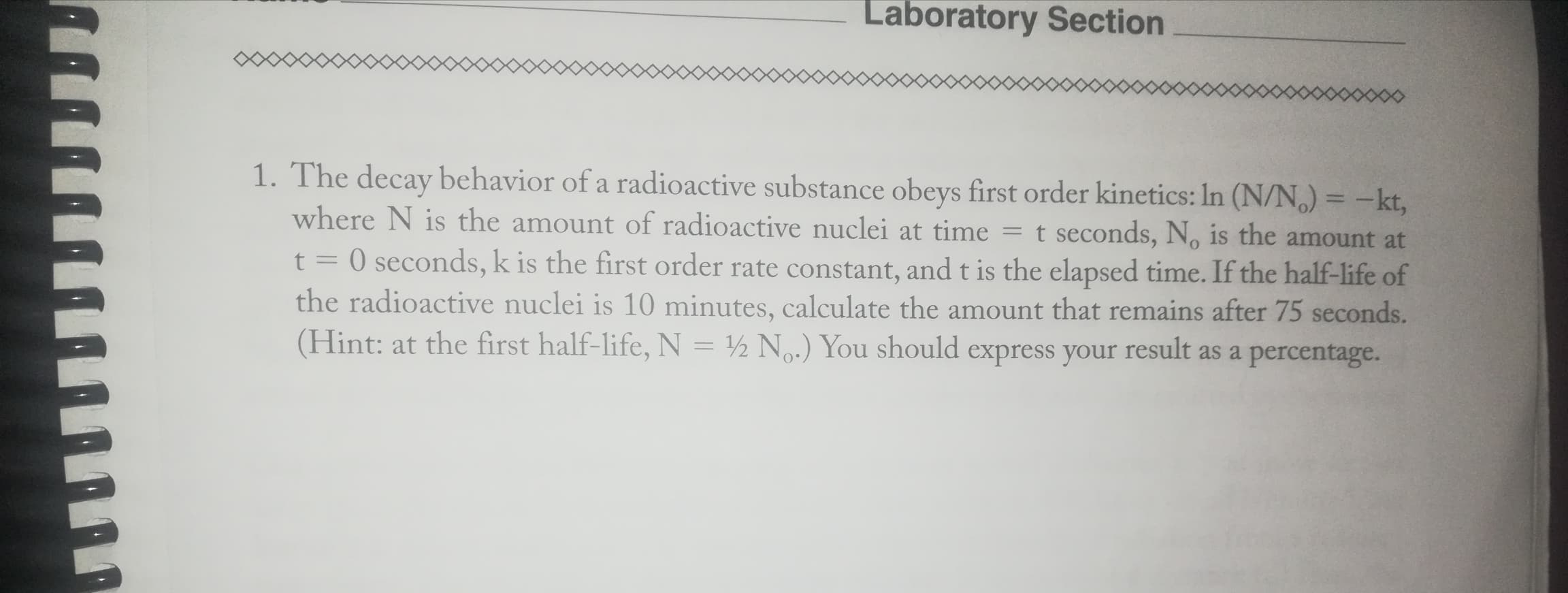The decay behavior of a radioactive substance obeys first order kinetics: In (N/N,) = -kt, where N is the amount of radioactive nuclei at time = t seconds, N, is the amount at O seconds, k is the first order rate constant, and t is the elapsed time. If the half-life of the radioactive nuclei is 10 minutes, calculate the amount that remains after 75 seconds. (Hint: at the first half-life, N = ½ N.) You should express your result as a percentage.
The decay behavior of a radioactive substance obeys first order kinetics: In (N/N,) = -kt, where N is the amount of radioactive nuclei at time = t seconds, N, is the amount at O seconds, k is the first order rate constant, and t is the elapsed time. If the half-life of the radioactive nuclei is 10 minutes, calculate the amount that remains after 75 seconds. (Hint: at the first half-life, N = ½ N.) You should express your result as a percentage.
Chemistry: Principles and Practice
3rd Edition
ISBN:9780534420123
Author:Daniel L. Reger, Scott R. Goode, David W. Ball, Edward Mercer
Publisher:Daniel L. Reger, Scott R. Goode, David W. Ball, Edward Mercer
Chapter13: Chemical Kinetics
Section: Chapter Questions
Problem 13.49QE: When formic acid is heated, it decomposes to hydrogen and carbon dioxide in a first-order decay....
Related questions
Question
1

Transcribed Image Text:The decay behavior of a radioactive substance obeys first order kinetics: In (N/N,) = -kt,
where N is the amount of radioactive nuclei at time = t seconds, N, is the amount at
O seconds, k is the first order rate constant, and t is the elapsed time. If the half-life of
the radioactive nuclei is 10 minutes, calculate the amount that remains after 75 seconds.
(Hint: at the first half-life, N = ½ N.) You should express your result as a percentage.
Expert Solution
This question has been solved!
Explore an expertly crafted, step-by-step solution for a thorough understanding of key concepts.
This is a popular solution!
Trending now
This is a popular solution!
Step by step
Solved in 5 steps with 3 images

Knowledge Booster
Learn more about
Need a deep-dive on the concept behind this application? Look no further. Learn more about this topic, chemistry and related others by exploring similar questions and additional content below.Recommended textbooks for you

Chemistry: Principles and Practice
Chemistry
ISBN:
9780534420123
Author:
Daniel L. Reger, Scott R. Goode, David W. Ball, Edward Mercer
Publisher:
Cengage Learning

Chemistry & Chemical Reactivity
Chemistry
ISBN:
9781337399074
Author:
John C. Kotz, Paul M. Treichel, John Townsend, David Treichel
Publisher:
Cengage Learning

Chemistry: Principles and Reactions
Chemistry
ISBN:
9781305079373
Author:
William L. Masterton, Cecile N. Hurley
Publisher:
Cengage Learning

Chemistry: Principles and Practice
Chemistry
ISBN:
9780534420123
Author:
Daniel L. Reger, Scott R. Goode, David W. Ball, Edward Mercer
Publisher:
Cengage Learning

Chemistry & Chemical Reactivity
Chemistry
ISBN:
9781337399074
Author:
John C. Kotz, Paul M. Treichel, John Townsend, David Treichel
Publisher:
Cengage Learning

Chemistry: Principles and Reactions
Chemistry
ISBN:
9781305079373
Author:
William L. Masterton, Cecile N. Hurley
Publisher:
Cengage Learning

Chemistry: The Molecular Science
Chemistry
ISBN:
9781285199047
Author:
John W. Moore, Conrad L. Stanitski
Publisher:
Cengage Learning

Chemistry for Engineering Students
Chemistry
ISBN:
9781337398909
Author:
Lawrence S. Brown, Tom Holme
Publisher:
Cengage Learning

Chemistry by OpenStax (2015-05-04)
Chemistry
ISBN:
9781938168390
Author:
Klaus Theopold, Richard H Langley, Paul Flowers, William R. Robinson, Mark Blaser
Publisher:
OpenStax